Art Lovers discussion
Picture of the Day
>
June 2020 - Made in Japan
 Connie wrote: "I've always loved Hokusai's print. I can tell already that I'm going to enjoy this month's theme!"
Connie wrote: "I've always loved Hokusai's print. I can tell already that I'm going to enjoy this month's theme!"I certainly hope so!
 Dirk wrote: "Connie wrote: "I've always loved Hokusai's print. I can tell already that I'm going to enjoy this month's theme!"
Dirk wrote: "Connie wrote: "I've always loved Hokusai's print. I can tell already that I'm going to enjoy this month's theme!"I certainly hope so!"
Hmmmm - I'm thinking it will be a watery June!
 Chris wrote: "Dirk wrote: "Connie wrote: "I've always loved Hokusai's print. I can tell already that I'm going to enjoy this month's theme!"
Chris wrote: "Dirk wrote: "Connie wrote: "I've always loved Hokusai's print. I can tell already that I'm going to enjoy this month's theme!"I certainly hope so!"
Hmmmm - I'm thinking it will be a watery June!"
Wouldn't that be a little bit too easy?
 Remember last year’s summer months?
Remember last year’s summer months?When we did the little history of Abstract art?
Here’s one that didn’t make the cut then:
Kazuo Nakamura
(1926 - 2002)
Kazuo Nakamura was a Japanese-Canadian painter and sculptor and a founding member of the Toronto-based Painters Eleven group in the 1950s.
https://en.wikipedia.org/wiki/Kazuo_N...

Hillside
1954
Oil on canvas
 Well, if we are supposed to remember last summer's abstract art themes, I will definitely like this month's theme! Last summer's themes were my favorites by far. Not that several other months haven't also been up there, too.
Well, if we are supposed to remember last summer's abstract art themes, I will definitely like this month's theme! Last summer's themes were my favorites by far. Not that several other months haven't also been up there, too.
 Ohara Koson
Ohara Koson(1877– 1945)
Ohara Koson was a Japanese painter and print designer of the late 19th and early 20th centuries, part of the shin-hanga ("new prints") movement.
https://en.wikipedia.org/wiki/Ohara_K...
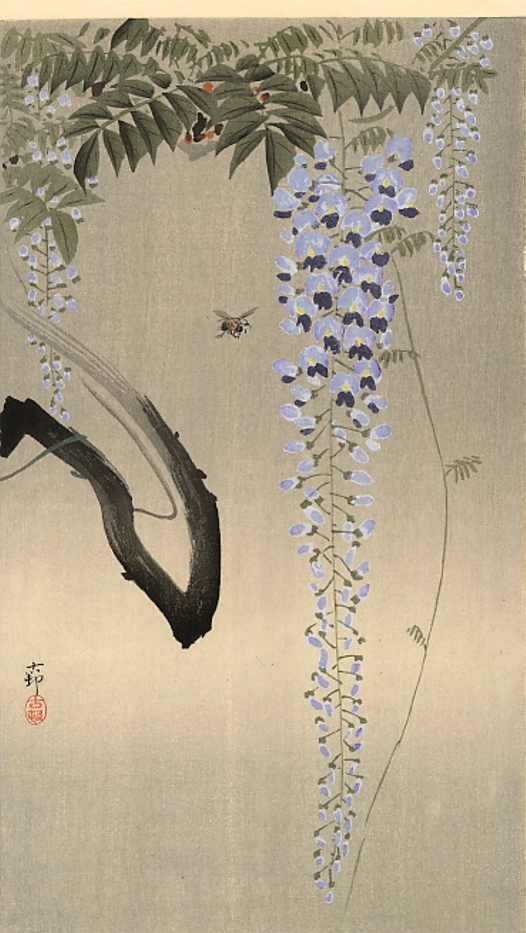
Wisteria and Bee
1930
pen and ink on paper
 For today I have a contemporary artist
For today I have a contemporary artistTakato Yamamoto
(B.1960)
Takato Yamamoto is a Japanese painter and manga artist. He is most known for developing a unique style that he termed “Heisei aestheticism”, which blends influences from Japanese ukiyo-e painting with Western gothic art to create dark, but beautiful images. His surrealistic and highly detailed works often explore themes of violence, death and sexuality to create unsettling and highly symbolic imagery.
http://www.muddycolors.com/2019/05/ar...

Kusa-meikyu
2013
 Today’s artist is even younger:
Today’s artist is even younger:Aya Takano
(B.1976)
Aya Takano is a Japanese Superflat artist, manga artist, and science fiction essayist.
https://en.wikipedia.org/wiki/Aya_Takano

EVERY DAY IS A CARNIVAL
signed ‘Aya Takano’ in English; dated 2012 (on the reverse)
acrylic on canvas
130 x 162 cm.
Sold by Christie’s Hong Kong on 26 november 2016 for HKD 1,620,000
 Utagawa Kuniyoshi
Utagawa Kuniyoshi(1798 - 1861)
Utagawa Kuniyoshi was one of the last great masters of the Japanese ukiyo-e style of woodblock prints and painting. He was a member of the Utagawa school.
The range of Kuniyoshi's subjects included many genres: landscapes, beautiful women, Kabuki actors, cats, and mythical animals. He is known for depictions of the battles of legendary samurai heroes. His artwork incorporated aspects of Western representation in landscape painting and caricature.
https://en.wikipedia.org/wiki/Utagawa...

Sharks
1814
 Toyohara Chikanobu
Toyohara Chikanobu(1838- 1912)
Toyohara Chikanobu better known to his contemporaries as Yōshū Chikanobu (楊洲周延), was a prolific woodblock artist of Japan's Meiji (era).
https://en.wikipedia.org/wiki/Toyohar...

Flower arrangement and tea ceremony
no more info found.
 Goyō Hashiguchi
Goyō Hashiguchi(1880 - 19821)
Goyō Hashiguchi was an artist in Japan, born Hashiguchi Kiyoshi in Kagoshima Prefecture. His father Hashiguchi Kanemizu was a samurai and amateur painter in the Shijō style. His father hired a teacher in the Kano style of painting in 1899 when Kiyoshi was only ten. Kiyoshi took the name of Goyō while attending the Tokyo School of Fine Arts, from which he graduated best in his class in 1905. The name Goyō was chosen because of his fondness for the five needle pine in his father's garden.
https://en.wikipedia.org/wiki/Goyō_Ha...
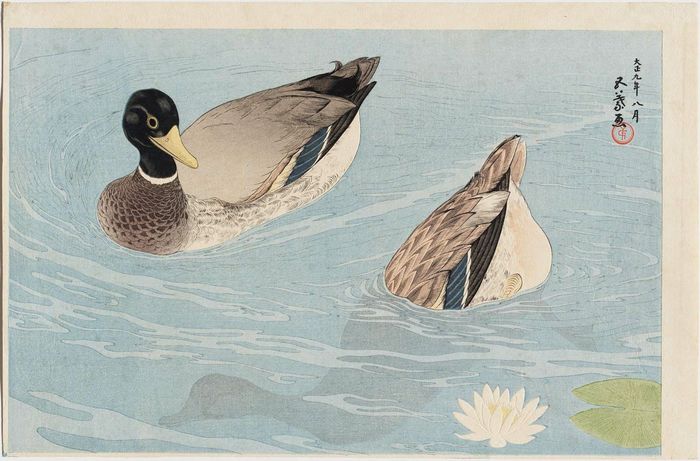
Ducks
1920
Woodblock print
26,7 x 40,6 cm
 Kiyoshi Saitō
Kiyoshi Saitō(1907- 1997)
Kiyoshi Saitō born in Aizubange, Fukushima, was a sōsaku-hanga artist in 20th-century Japan. In 1938, he issued his first prints in his now famous "Winter in Aizu" series. Saitō was one of the first Japanese printmaking artists to have won at the São Paulo Biennale in 1951. Saitō's early works depict villages populated with local Japanese with a high degree of realism and three-dimensionality. His more mature works merge modern elements with Japanese tradition. His prints feature architecture and plant life flattened in two-dimensionality.
https://en.wikipedia.org/wiki/Kiyoshi...

Ecstasy
1953
color woodblock print on paper
84.5 cm x 54.5 cm
 Takeji Asano
Takeji Asano(1900- 1999
Asano Takeji was one of many cross-over artists who worked in both the shin hanga (new prints) and sōsaku hanga (creative prints) styles. Born in Kyoto in 1900, he graduated from the Kyoto City School of Fine Arts and Crafts in 1919 and the Kyoto Municipal College of Painting in 1923. He first learned Western oil painting and then turned to Japanese-style painting under Bakusen Tsuchida (1887-1936). In 1928, he became interested in woodblock printing through a course offered at Gasendo in Kyoto, by Hiratsuka Un'ichi (1895-1997), one of the founders of the sōsaku hanga movement. He was active in the formation of the Kyoto Sosaku-Hangakai (Kyoto Creative Print Society) in 1929 along with Tokuriki Tomikichirō (1902-2000), Asada Benji (1899-1984), Kawai Unosuke (1889-1968), and others. In 1930, he participated with Tokuriki and Asada in creating the series Creative Prints of Twelve Months in New Kyoto (Sosaku-hanga shin Kyoto junikagetsu) published by Uchida Publishing. In the early 1930s he contributed to the magazine Taishu hanga (Popular Prints), published by Kyoto Sosaku-Hangakai. Also in the early-30s he worked on a self-carved and self-printed set of views of the Kyoto area, two designs of which are represented in this collection. In 1947, he created the self-carved, self-printed series Noted Views in the Kyoto-Osaka Area (Kinki meisho fukei). Starting in the 1950s, Asano designed a large number of shin hanga style prints for the Unsodo Publishing company, which continue to be printed to this day. He was an associate member of Nihon Hanga Kyokai from 1955-1960. He became friends with the American artist Ben Shahn (1898-1969), during Shahn’s visit to Japan in 1964, and continued that friendship until Shahn's death.
http://www.myjapanesehanga.com/home/a...
https://www.wikiart.org/en/asano-takeji
https://ukiyo-e.org/artist/asano-takeji

Rain in Kiyomizu Temple
1953
 Glad you're enjoying this Carol!
Glad you're enjoying this Carol!Moving a bit into the abstract:
Hiroyuki Tajima
(1911- 1984)
Hiroyuki Tajima was a Japanese printmaker of the sōsaku-hanga school. He was born in Tokyo and graduated from Nihon University in 1932. In 1943, he graduated from the Western-style painting division of the Tokyo School of Fine Arts. He created his first print in 1946, and joined the Bijutsu Bunka Kyokai (a group of abstract and surrealist artists) the same year. He also studied Nagase Yoshi (1891–1978), an artist of the Sōsaku-hanga school. In 1963, he became a member of the Nihon Hanga Kyokai (Japanese Print Association).
He is best known for his totally abstract prints with broad areas of rich dense color.
https://en.wikipedia.org/wiki/Hiroyuk...

Nontitle 2
1974
 Jiro Yoshihara
Jiro Yoshihara(1905- 1972)
Jiro Yoshihara was a Japanese painter. In 1954, along with Shōzō Shimamoto, he co-founded the avant-garde Gutai group in Osaka. He was a businessman and scion of a family that owned a cooking-oil company, along with a group of young, Hanshin-region artists. Yoshihara had taught Western-style painting before becoming Gutai’s leader. Yoshihara wrote the "Gutai Manifesto" in 1956 and was the leader of the so named group of internationally acclaimed avant-garde artists representative of Japan's post-war art world. He worked in surrealist and abstract expressionist painting styles before turning, in his final years, to the repeated depiction of circles reminiscent of "satori," the enlightenment of Zen. This white circle was made by leaving the canvas unpainted while painting the background black. When asked about his circles, Yoshihara said that he could not manage to paint even one circle with satisfaction, an indication of the depths of his pursuit of this form. Indeed, no two of his circles are shaped exactly alike. He was the leader of the Gutai Group until his death in 1972.
https://en.wikipedia.org/wiki/Jiro_Yo...

unknown title
1960
 Yayoi Kusama
Yayoi Kusama(B1929)
Yayoi Kusama is a Japanese contemporary artist who works primarily in sculpture and installation, but is also active in painting, performance, film, fashion, poetry, fiction, and other arts. Her work is based in conceptual art and shows some attributes of feminism, minimalism, surrealism, Art Brut, pop art, and abstract expressionism, and is infused with autobiographical, psychological, and sexual content. She has been acknowledged as one of the most important living artists to come out of Japan.
https://en.wikipedia.org/wiki/Yayoi_K...
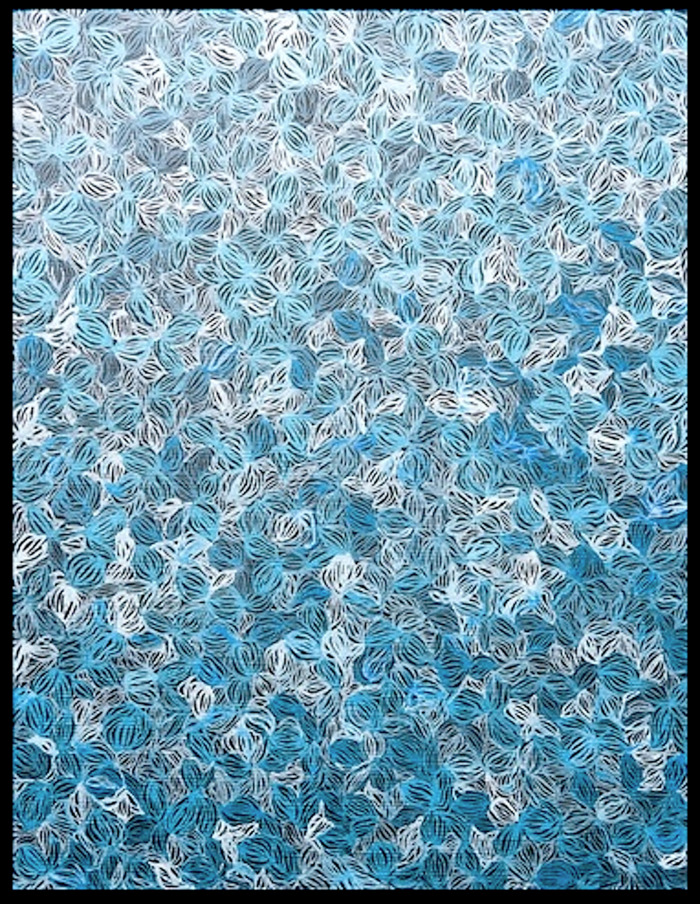
Sea
2005
acrylic on canvas
41 x 31.8 cm.
For a lot more of her you can see this post by Heather:
https://www.goodreads.com/topic/show/...
 One of the oldest artists today, according to Wikipedia she was born in 1913 and still alive which makes her 107 years old!
One of the oldest artists today, according to Wikipedia she was born in 1913 and still alive which makes her 107 years old!Toko Shinoda
(B.: 1913 )
Toko Shinoda (篠田 桃紅, Shinoda Tōkō, born March 28, 1913) is a Japanese artist working with sumi ink paintings and prints. Her art merges traditional calligraphy with modern abstract expressionism. A 1983 interview in Time magazine asserted "her trail-blazing accomplishments are analogous to Picasso's". Shinoda's works had been exhibited in the Hague National Museum, the Art Institute of Chicago, Cincinnati Art Museum and other leading museums in the world.
https://en.wikipedia.org/wiki/Toko_Sh...

Blessing
1983
 Kazuo Shiraga
Kazuo Shiraga(1924 – 2008)
Kazuo Shiraga was a Japanese modern artist who belonged to the Gutai group of avant-garde artists. He was acknowledged internationally only after his death.
Shiraga is said to have seen the viscosity of tube-ready oil paint as "free." This is compared to the paints he was forced to use in painting school, which were thin ink-based paints. Shiraga would experiment by using his hands and fingers with oil paints in his younger years.[1]
In the 1940s he studied Nihonga at the Kyoto City University of Arts. In 1953 he founded the group "Zero Kai" with Akira Kanayama, Atsuko Tanaka and Saburo Murakami which merged with Gutai in 1955.[2] Shiraga created "mud paintings" by using his whole body to leave impressions in wet mud.[3] For over tens years, from 1956 to 1966, his Performance Paintings were largely painted with his feet. Later he was influenced by Frenchman Jean-Jacques Lebel. 1971-72 he lived as a Buddhist monk.
In December 2014 his prime-period 1961 abstract, “Chijikusei Gotenrai,” was sold for 3.25 million euros, about $3.7 million.[4]
https://en.wikipedia.org/wiki/Kazuo_S...
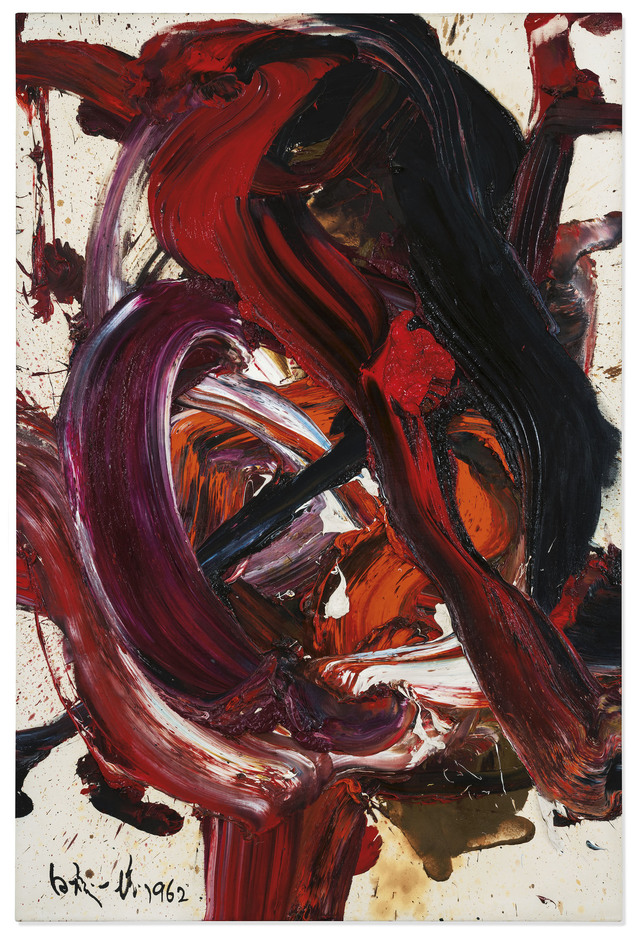
Chinzei Hachirotametomo
signed in Japanese and dated '1962' (lower left); signed, titled in Japanese and dated '1962.8 Kazuo Shiraga' (on the reverse)
oil on canvas
193.5 x 131cm
Painted in 1962
Sold by Christie’s 4 October 2019 (for GBP 2,531,250
 Today’s artist maybe Japanese but he lived most of his live in São Paulo, Brazil.
Today’s artist maybe Japanese but he lived most of his live in São Paulo, Brazil.Manabu Mabe
(1924 - 1997)
Manabu Mabe was a Japanese-Brazilian painter. Born in Kumamoto he moved with his parents to Brazil at age 10. Mabe worked as a vendor of hand-painted ties in São Paulo before becoming a famous artist.
In the late 1950s, Mabe won the top award in São Paulo's Contemporary Art Salon, the top award as Brazil's best painter in the São Paulo Bienal, and the top honors for artists under 35 at Paris's first biennial.
On January 30, 1979, after an exhibition in Tokyo, 53 of his paintings were on board a Varig cargo Boeing 707-323C en route from Tokyo - Narita to Rio de Janeiro-Galeão via Los Angeles. The aircraft went missing over the Pacific Ocean some 30 minutes (200 km ENE) from Tokyo. The cause is unknown since the wreck was never found. The paintings were lost.
His works are currently displayed in the permanent exhibitions of the São Paulo Contemporary Art Museum, the Modern Art Museum in Rio de Janeiro, the Boston Contemporary Art Museum, the Beaux-Arts Museum of Dallas among others. The Rio de Janeiro National Museum for the Beaux-Arts lodges the most expressive paintings of a Still Nature (oil on canvas). Other institutions that display his work are the National Art Museum of Bolivia and the V+R Sapoznik Art Collection.
Mabe died in São Paulo on September 22, 1997.
https://en.wikipedia.org/wiki/Manabu_...
https://pt.wikipedia.org/wiki/Manabu_...

Untitled (No. AC27)
1972
oil on canvas 51.4 x 59.2 cm.
signed and dated 'MABE, 72' (lower right) signed and dated again, and inscribed 'No. AC27...
Sold at Christie’s NY , November 2012 (US$ 18,750)
 Kazuaki Tanahashi
Kazuaki Tanahashi(B. 1933)
Kazuaki Tanahashi is an accomplished Japanese calligrapher, Zen teacher, author and translator of Buddhist texts from Japanese and Chinese to English, most notably works by Dogen (he began his translation of Shobogenzo in his twenties). He first met Shunryu Suzuki in 1964, and upon reading Suzuki's book Zen Mind, Beginner's Mind he stated, "I could see it's Shobogenzo in a very plain, simple language." He has helped notable Zen teachers author books on Zen Buddhism, such as John Daido Loori. A fellow of the World Academy of Art and Science—Tanahashi is also an environmentalist and peaceworker.
https://en.wikipedia.org/wiki/Kazuaki...
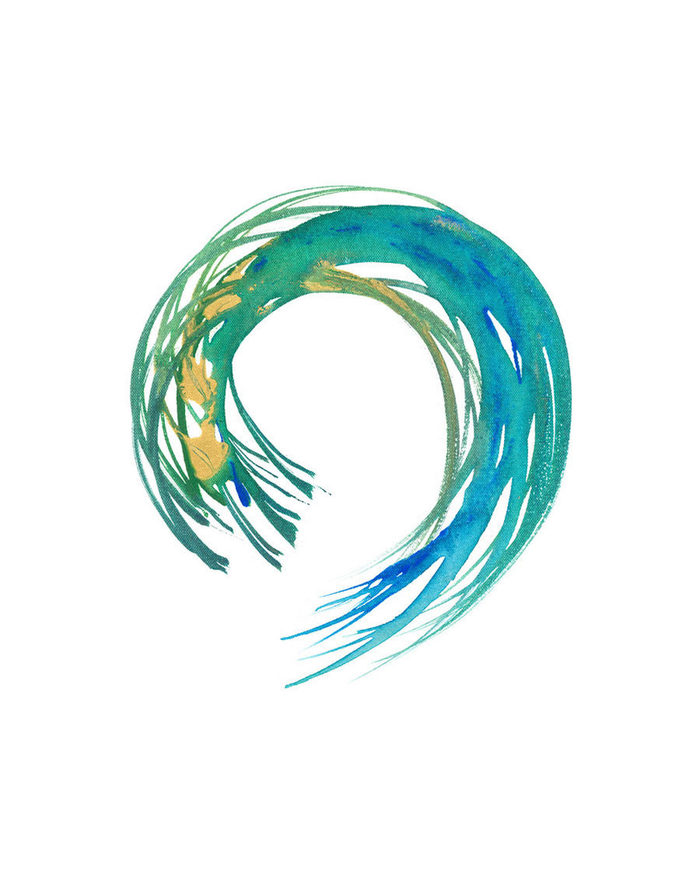
Miracles of each moment (green)
Available as serigraph since 2006
50x40 cm
 Dirk wrote: "Kazuaki Tanahashi
Dirk wrote: "Kazuaki Tanahashi(B. 1933)
Kazuaki Tanahashi is an accomplished Japanese calligrapher, Zen teacher, author and translator of Buddhist texts from Japanese and Chinese to English, most notably wor..."
Beautiful!
 Working in the same minimalist style is the next artist, however I’m cheating here a little bit since he was not born in Japan but in Korea.
Working in the same minimalist style is the next artist, however I’m cheating here a little bit since he was not born in Japan but in Korea.Lee Ufan
(B. 1936)
Lee Ufan is a Korean minimalist painter and sculptor artist and academic, honored by the government of Japan for having "contributed to the development of contemporary art in Japan." The art of this artist, who has long been based in Japan, is rooted in an Eastern appreciation of the nature of materials and also in modern European phenomenology. The origin of Mono-ha may be found in Lee's article "Sonzai to mu wo koete Sekine Nobuo ron (Beyond Being and Nothingness – A Thesis on Sekine Nobuo." Once this initial impetus given, Mono-ha congealed with the participation of the students of the sculptor Saito Yoshishige, who was teaching at Tama University of Art at the time. One evidence may be found in the book [ba, so, toki] (場 相 時, place phase time) (Spring, 1970). Lee, the main theorist of the Mono-ha (“School of Things”) tendency in Japan in the late 1960s and early 1970s, was trained as a philosopher. As a painter, Lee contributed to 'Korean Monotone Art' (Dansaekjo Yesul, 單色調 藝術), the first artistic movement in 20th century Korea to be promoted in Japan. He advocates a methodology of de-westernization and demodernization in both theory and practice as an antidote to the Eurocentric thought of 1960s postwar Japanese society. Lee divides his time between Kamakura, Japan and Paris, France.
https://en.wikipedia.org/wiki/Lee_Ufan

From Point
1975
Water color
 The Ufan is beautiful. It looks very much like Joan Mitchel, particularly she one painted 2 years later than this. Interesting.
The Ufan is beautiful. It looks very much like Joan Mitchel, particularly she one painted 2 years later than this. Interesting.
 Ruth wrote: "The Ugandan is beautiful. It looks very much like Joan Mitchel, particularly she one painted 2 years later than this. Interesting."
Ruth wrote: "The Ugandan is beautiful. It looks very much like Joan Mitchel, particularly she one painted 2 years later than this. Interesting."Good point Ruth. Joan Mitchell is one of my favorite artists and last year I posted a work of her in the Pic of the day in August:
https://www.goodreads.com/topic/show/...
I had a quick search and maybe this is what you were thinking of?
It is called Bear Right and dates from 1977:
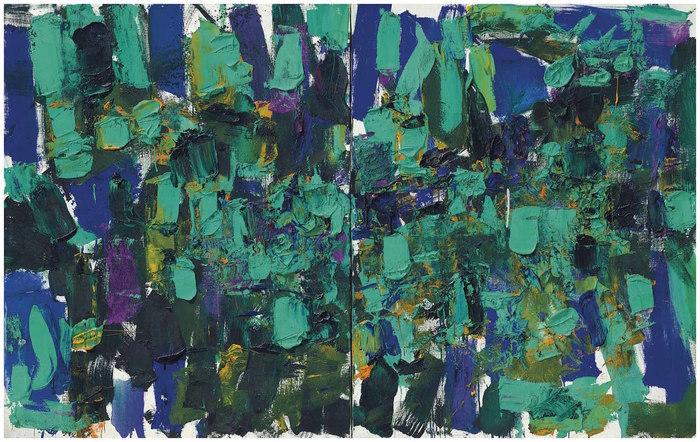
 Ruth wrote: "The Ufan is beautiful. It looks very much like Joan Mitchel, particularly she one painted 2 years later than this. Interesting."
Ruth wrote: "The Ufan is beautiful. It looks very much like Joan Mitchel, particularly she one painted 2 years later than this. Interesting."Exactly that one. Although there are a few that are similar.
 The next artist was already mentioned a couple of days ago (post of June 12: Jiro Yoshihara):
The next artist was already mentioned a couple of days ago (post of June 12: Jiro Yoshihara):Shozo Shimamoto
(1928 - 2013)
Shozo Shimamoto was a Japanese artist.He was a co-founder (along with Jirō Yoshihara) of the avant garde Gutai group formed in the 1950s, and his works are in museum collections such as those of the Tate Gallery and the Tate Modern (in both London and Liverpool) and the Hyogo Prefectural Museum of Art in Kobe, Japan. New York Times art critic Roberta Smith has noted him as one of the most daring and independent experimentalists of the postwar international art scene in the 1950s. Internationally today he is especially noted for his work in the "mail art" genre, of which he was a pioneer. In 1997 his mail art works were shown in the solo exhibition "Shozo Shimamoto's Gutai & A.U." in the 'E-mail Art Archives' of Guy Bleus, Center for Visual Arts, Hasselt, Belgium.
https://en.wikipedia.org/wiki/Shozo_S...

Untitled
2010
signed ’S.Shimamoto’ (lower right)
acrylic and broken glasses on canvas (bottle crash)
142,9 x 123 cm
 Another female artist today and also member of the Gutai group:
Another female artist today and also member of the Gutai group:Atsuko Tanaka
(1932 - 2005)
Atsuko Tanaka was a pioneering Japanese avant-garde artist. She was a central figure in the Gutai Art Association, although her painting and performance art received relatively little international attention until the early 2000s, when she received her first solo show.
https://en.wikipedia.org/wiki/Atsuko_...

Untitled
1964
Acrylic on canvas
333,4 x 225,4 cm
MoMA
(not on view)
The colorful concentric circles and circuitous lines that compose this painting evolved from Tanaka's performance Electric Dress, premiered a decade before, in which she wore two hundred blinking incandescent lightbulbs and tubes covered with red, blue, yellow, and green enamel paint. The painting vividly records the artist's gestural application of layers and skeins of multicolored acrylic paint on the canvas as it lay on the floor. Such a performative practice was typical of members of Gutai, a group of Japanese artists (including Tanaka) active between 1954 and 1972. Gutai means "embodiment" or "concrete"; through their experimental works, these artists aimed to bring materials together with the human spirit.
https://www.moma.org/collection/works...
 Ay-O
Ay-O(B. 1931)
Takao Iijima (better known by his art name Ay-O, (靉嘔 Ai Ō) is a Japanese artist who has been associated with Fluxus since its international beginnings in the 1960s.
https://en.wikipedia.org/wiki/Ay-O

Heart Sutra
“Form is emptiness, emptiness is form,”
Color Screenprint
1981
36,8 x 28,6 cm
 Utagawa Hiroshige
Utagawa Hiroshige(1797-1858)
Utagawa Hiroshige was a Japanese ukiyo-e artist, considered the last great master of that tradition.
Hiroshige’s The Fifty-three Stations of the Tōkaidō (1833–1834) and One Hundred Famous Views of Edo (1856–1858) greatly influenced French Impressionists such as Monet. Vincent van Gogh copied two of the One Hundred Famous Views of Edo which were among his collection of ukiyo-e prints. Hiroshige's style also influenced the Mir iskusstva, a 20th-century Russian art movement in which Ivan Bilibin and Mstislav Dobuzhinsky were major artists. Dobuzhinsky confessed of Hiroshige's influence "I liked to choose a viewpoint of my own so that the composition would be striking, unusual; in that, I had the constant example of Hiroshige before my eyes". Cézanne and Whistler were also amongst those under Hiroshige's influence. Hiroshige was regarded by Louise Gonse, director of the influential Gazette des Beaux-Arts and author of the two volume L'Art Japonais in 1883, as the greatest painter of landscapes of the 19th century.
https://en.wikipedia.org/wiki/Hiroshige

Sudden Shower over Shin-Ōhashi bridge and Atake
1857
woodblock print
37 x 25 cm
https://en.wikipedia.org/wiki/Sudden_...
And since I posted Joan Mitchell a couple of days ago why not post Van Gogh’s copy ;-)
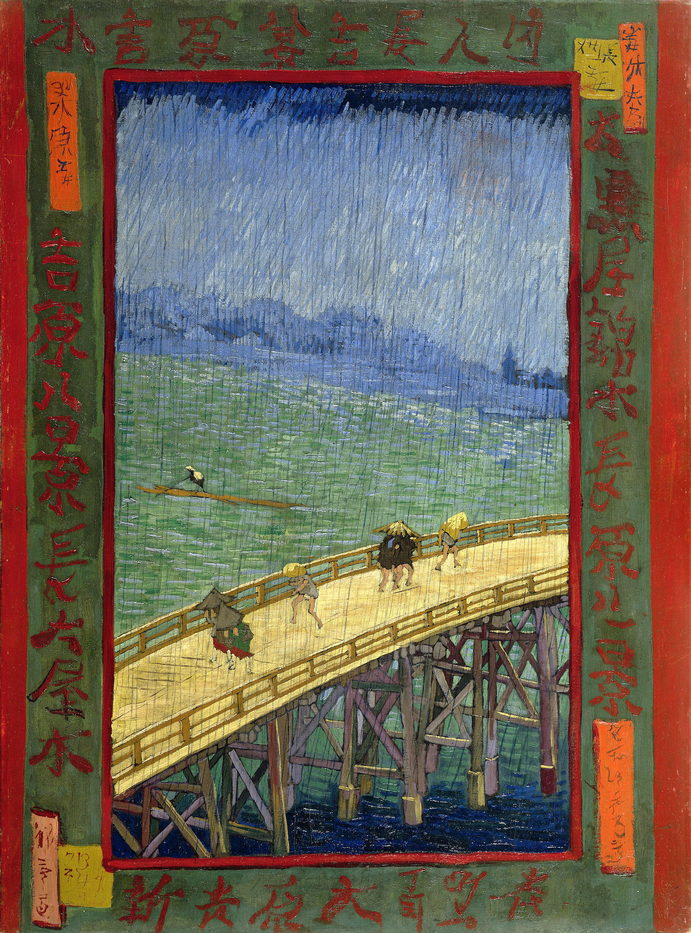
Brug in de regen. Naar Hiroshige.
 Shinsui Itō
Shinsui Itō(1898-1972)
Shinsui Itō was the pseudonym of a Nihonga painter and ukiyo-e woodblock print artist in Taishō- and Shōwa-period Japan. He was one of the great names of the shin-hanga art movement, which revitalized the traditional art after it began to decline with the advent of photography in the early 20th century. His real name was Itō Hajime
https://en.wikipedia.org/wiki/Shinsui...

Suzumi (Enjoying the Cool),
dated 1922,
A dai oban tate-e print from the series Shin bijin juni sugata (New 12 Images of Modern Beauties),
published by Watanabe Shozaburo (6mm Watanabe round seal),
signed Shinsui, with limited edition number 19/200 on verso
 Kiyokata Kaburagi
Kiyokata Kaburagi (1886-1972)
Kiyokata Kaburaki was the art-name of a Nihonga artist and the leading master of the bijin-ga genre in the Taishō and Shōwa eras. His legal name was Kaburaki Ken'ichi. The artist himself used the reading "Kaburaki", but many Western (and some Japanese) sources transliterate it as "Kaburagi".
https://en.wikipedia.org/wiki/Kiyokat...

The Dairy Sisters
Kuchi-e Print,
1905
Interesting kuchi-e scene of a young couple along the water's edge. The beauty recoils as her male companion offers a small book to her, leaning back on one hand. He wears the latest Western fashions including a collar and tie. Pine branches frame a view of the water and the shoreline beyond. A nicely detailed illustration for the 1905 novel "The Dairy Sisters."
 Torii Kotondo
Torii Kotondo(1900-1976)
Torii Kotondo born as Saitō Akira, was a Japanese artist of the Torii school of ukiyo-e artists. Kotondo lectured at Nihon University in Tokyo from 1966 to 1972. Collectors did not place high value on Kotondo's prints while he was alive; the prints have since appreciated in collectability and fetch prices comparable to those of the great masters
https://en.wikipedia.org/wiki/Torii_K...

Preparing Her Sash (pink variant)
1933
Shin-Hanga
woodblock print
 Shotei Takahashi
Shotei Takahashi(1871- 1945)
Takahashi Shōtei was a 20th-century Japanese woodblock artist in the shin-hanga art movement. As a young artist he was given the artistic name Shotei by his uncle, Matsumoto Fuko, under whose tutelage he was apprenticing. When he was 16 years old, he started a job with the Imperial Household Department of Foreign Affairs, where he copied the designs of foreign ceremonial objects.
https://en.wikipedia.org/wiki/Takahas...

Fuji from Lake Yamanaka
Color woodblock print I
(24.77 x 17.3 cm
 Ogata Gekko
Ogata Gekko(1859-1920)
Ogata Gekkō was a Japanese artist best known as a painter and a designer of ukiyo-e woodblock prints. He was self-taught in art, and won numerous national and international prizes and was one of the earliest Japanese artists to win an international audience.
https://en.wikipedia.org/wiki/Ogata_G...

Ryu sho ten (Dragon rising to the heavens)
1897
Ukiyo-e print
Printed on Nov 1st, 30 of Meiji [1897], published on the same month 5th. Printed and published by Heikichi Matsuki.
 Suzuki Harunobu
Suzuki Harunobu(1725 - 1770)
Suzuki Harunobu was a Japanese designer of woodblock print art in the Ukiyo-e style. He was an innovator, the first to produce full-color prints (nishiki-e) in 1765, rendering obsolete the former modes of two- and three-color prints. Harunobu used many special techniques, and depicted a wide variety of subjects, from classical poems to contemporary beauties. Like many artists of his day, Harunobu also produced a number of shunga, or erotic images. During his lifetime and shortly afterwards, many artists imitated his style. A few, such as Harushige, even boasted of their ability to forge the work of the great master. Much about Harunobu's life is unknown.
https://en.wikipedia.org/wiki/Worthin...

Young Woman Jumping from the Kiyomizu Temple Balcony with an Umbrella as a Parachute
1765
Woodblock print
24 x 20,9 cm

Version from MFA Boston
https://collections.mfa.org/objects/2...
 I just love their lines..sooo clean? ... so minimalist yet expressive? Like Haiku .
I just love their lines..sooo clean? ... so minimalist yet expressive? Like Haiku .Short ..but Beautiful.
So... Precise ?
Maybe .
 Keisai Eisen
Keisai Eisen(1790 - 1848)
Keisai Eisen was a Japanese ukiyo-e artist who specialised in bijin-ga (pictures of beautiful women). His best works, including his ōkubi-e ("large head pictures"), are considered to be masterpieces of the "decadent" Bunsei Era (1818–1830). He was also known as Ikeda Eisen, and wrote under the name of Ippitsuan. In addition to producing a prolific number of prints, he was a writer, producing biographies of the Forty-seven Ronin and several books, including a continuation of the Ukiyo-e Ruiko (History of Prints of the Floating World), a book which documented the lives of the ukiyo-e artists. His supplement is known as "Notes of a Nameless Old Man." He describes himself as a dissolute hard-drinker and claims to have been the owner of a brothel in Nezu in the 1830s which had burned down.
https://en.wikipedia.org/wiki/Keisai_...
Famous for his portraits of beautiful ladies, but I like his landscapes a bit more:
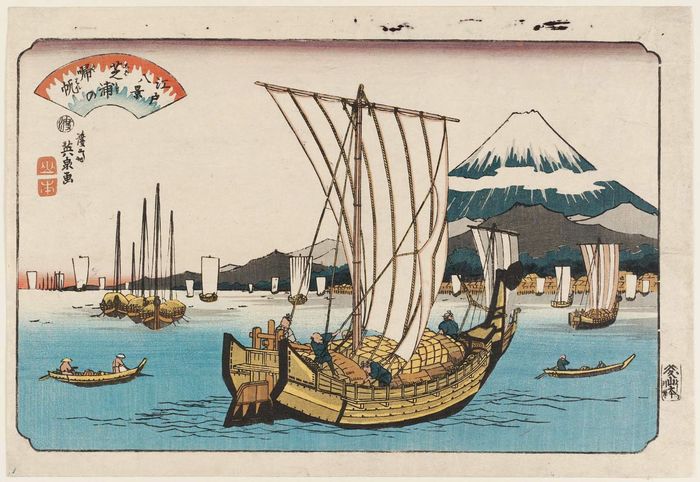
Returning Sails at Shiba Bay
1847
Woodblock print (nishiki-e); ink and color on paper
25.4 x 37.2 cm
 Our last artist of this month is one we already encountered in March:
Our last artist of this month is one we already encountered in March:https://www.goodreads.com/topic/show/...
Tōshi Yoshida
(1911 - 1995)
Tōshi Yoshida (吉田 遠志, Yoshida Tōshi, July 25, 1911 – July 1, 1995) was a Japanese printmaking artist associated with the sōsaku-hanga movement, and son of shin-hanga artist Hiroshi Yoshida. .
https://en.wikipedia.org/wiki/Tōshi_Y...
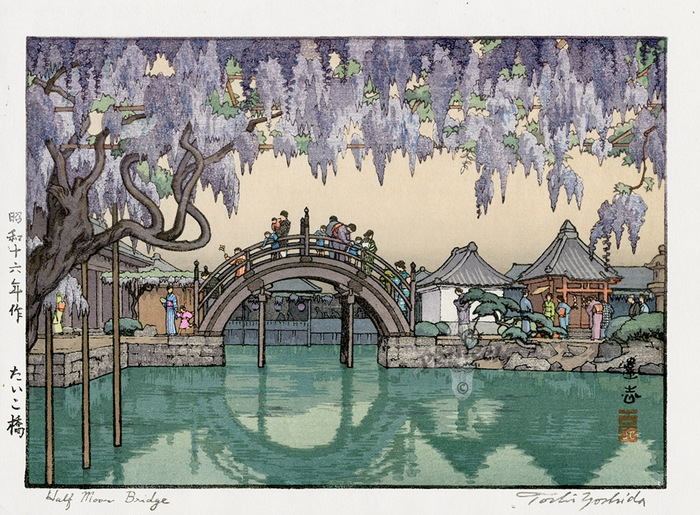
Half Moon Bridge
And why not post another of his prints (To be honest I found it difficult to chose between them)
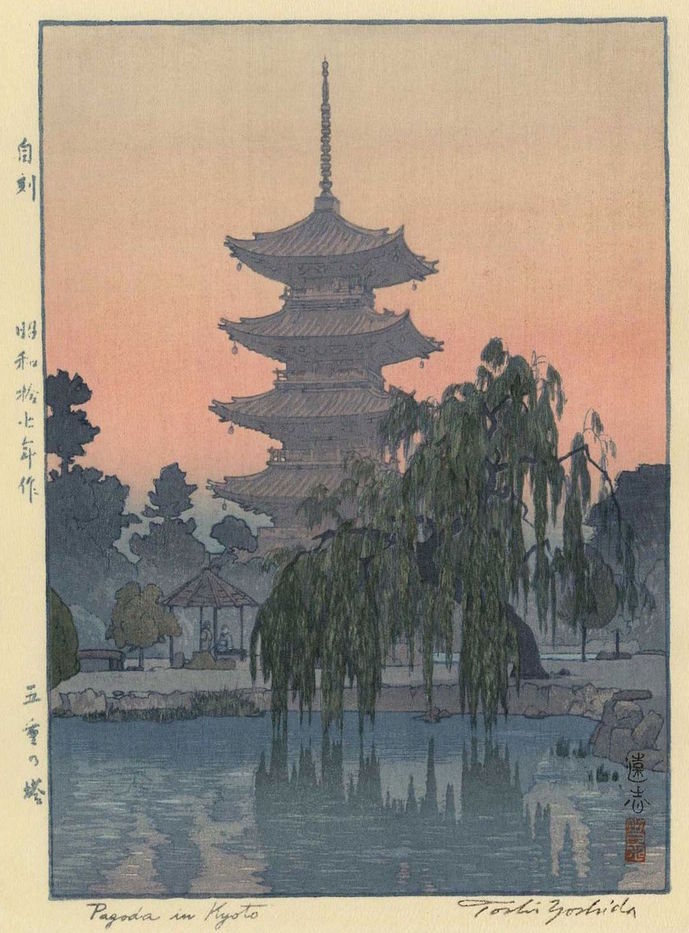
Pagoda in Kyoto
 Ruth wrote: "I’ve truly enjoyed this month’s art. Thank you so much, Dirk."
Ruth wrote: "I’ve truly enjoyed this month’s art. Thank you so much, Dirk."You're welcome Ruth! It was all my pleasure. I'm a big fan of these Japanese woodblock prints.
But I also discovered some beautiful abstract works while searching for modern works.
Another month is finished, time to move on to the summer months ;-)
 Connie wrote: "The Japanese woodblocks are lovely, Dirk. It was a real treat to view your selections every day."
Connie wrote: "The Japanese woodblocks are lovely, Dirk. It was a real treat to view your selections every day."Thank you Connie, it was only a small selection!
If you take a look on the Wikipedia page for Japanese woodblock artists, you can find links to more than 60 artists:
https://en.wikipedia.org/wiki/Categor...



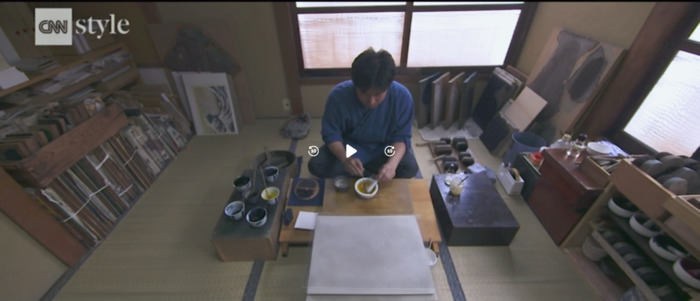


Please don’t post any pictures here, the only rule to this thread is that the person running this thread can post a picture here. You are welcome to comment on the one posted that day or any other day in the month, or on other people's comments, you can say whatever you want (keeping with the rules of the group of course).
So please don't post a picture in this thread. That's all!
Enjoy!
01/06/20
Lets start with a pic that is really famous:
Katsushika Hokusai
(1760 - 1849)
Katsushika Hokusai was a Japanese artist, ukiyo-e painter and printmaker of the Edo period. Born in Edo (now Tokyo), Hokusai is best known as author of the woodblock print series Thirty-six Views of Mount Fuji (富嶽三十六景, Fugaku Sanjūroku-kei, c. 1831) which includes the internationally iconic print, The Great Wave off Kanagawa.
https://en.wikipedia.org/wiki/Hokusai
The Great Wave off Kanagawa
1829-1833
color woodblock
25,7 x 37,8 cm
The Great Wave off Kanagawa (神奈川沖浪裏, Kanagawa-oki Nami Ura, lit. '"Under a wave off Kanagawa"'), also known as The Great Wave or simply The Wave, is a woodblock print by the Japanese ukiyo-e artist Hokusai. It was published sometime between 1829 and 1833. in the late Edo period as the first print in Hokusai's series Thirty-six Views of Mount Fuji. It is Hokusai's most famous work and one of the most recognizable works of Japanese art in the world.
https://en.wikipedia.org/wiki/The_Gre...